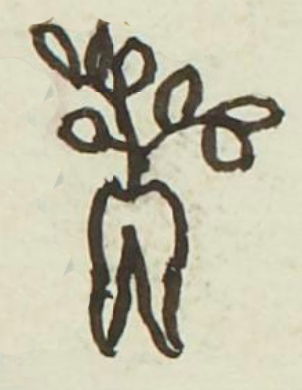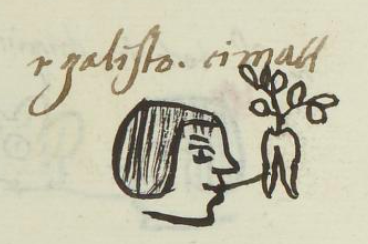Cimatl (MH575r)
This black-line drawing of the simplex glyph for the personal name Cimatl (“Wild Potato,” attested here as a man’s name) shows a bifurcated root with two leafy sprigs above. The term cimatl sometimes refers to the root specifically. According to the Florentine Codex (1963, Book 11, 125 and 133), if not properly cooked, the root can cause vomiting and diarrhea. Thus, perhaps it can serve as a medicinal when a healer wishes to induce vomiting. According to Clavijero (1780) this was a medicinal plant. The plant above ground is the cuauheco and/or the cimapatli (cimapahtli, with the glottal stop).
Stephanie Wood
The cimatl is still widely eaten in Mexico according to Michel Conan, Sacred Gardens and Landscapes (2007, 85). It is interesting how common the name Cima and Cimatl were in the sixteenth century; perhaps it was a comment on the roundness or length of the baby who received this name. While this Cima and Cimatl are frequently a man's name, another Cimatl (in another source) was the mother of the interpreter to Cortés, doña Marina. (See: Antoinette Sedillo López, Latina Issues, 2020.)
Stephanie Wood
galisto. cimatl
Calixto Cimatl
Stephanie Wood
1560
Jeff Haskett-Wood
herbs, hierbas, roots, raíces, medicinas, cima, nombres de hombres

cima(tl), edible medicinal root of an herb, https://nahuatl.wired-humanities.org/content/cimatl
Raíz o Tubérculo Comestible
Stephanie Wood
Matrícula de Huexotzinco, folio 575r, https://www.loc.gov/resource/gdcwdl.wdl_15282/?sp=229&st=image
This manuscript is hosted by the Library of Congress and the World Digital Library; used here with the Creative Commons, “Attribution-NonCommercial-ShareAlike 3.0 License” (CC-BY-NC-SAq 3.0).








